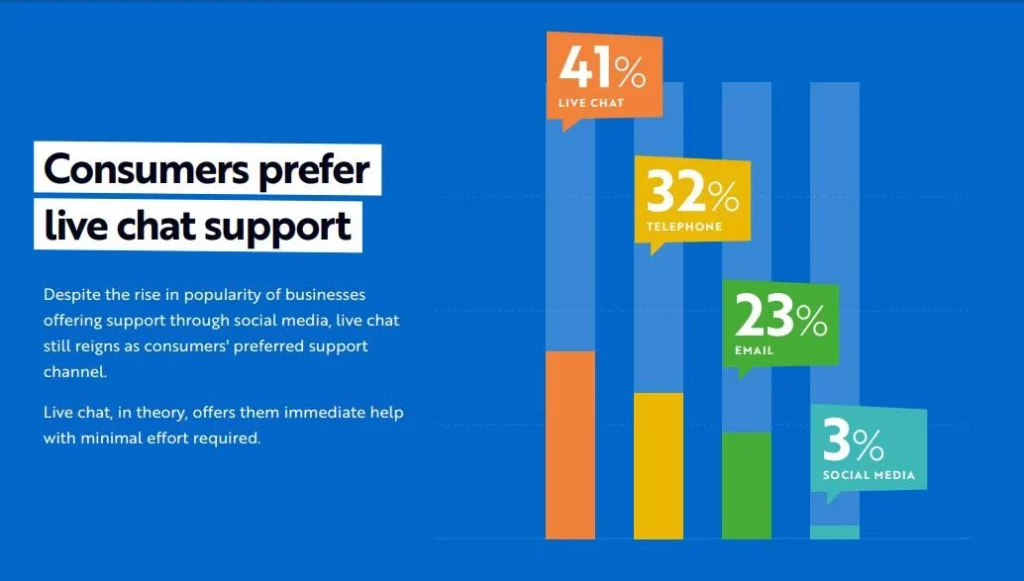Listen to this podcast on your favorite platform
Here we breakdown how to improve customer satisfaction by providing outstanding chat support.
When I have a query or question while booking air tickets or checking my online bank account, I am inclined to first check to see if the website offers a live chat customer service, before choosing to call or send an email.
Live chat support is preferred by many over other customer service channels, as you can multi-task and feel personally attended, receiving responses to queries within minutes.
Source: https://econsultancy.com/blog/63867-consumers-prefer-live-chat-for-customer-service-stats/
In comparison, speaking to a customer rep over the phone usually involves a series of automated prompts and lots of waiting to get a person at the end of the line – a frustrating combination, especially when you want quick answers. On the other hand, shooting an email off to an invisible customer support team, leaves me wondering when I will hear back.
Turns out I’m not the only one thinking this way. A report released by Zendesk titled the Customer Service Benchmark found that live chat was the channel that produced the highest level of customer satisfaction, beating phone and email.
Chat has become the leading contact source within the online environment, with 42% of customers using chat vs email (23%) or other social media forum (16%). (Source: J.D. Power)
Companies have recognized its popularity with customers and have implemented it in recent years. However, many companies struggle to get it right and have problems managing it effectively.
Here are a few pointers to keep in mind if you are looking to train your team to use live chat support to satisfy your online customers and effectively deal with their queries.
#1 – Keep it personal and engaging
Approach a chat session like a conversation. It helps to inject cheer and personality as this builds rapport and trust from the beginning. Use an informal and friendly tone to convey that you are ready and willing to help.
#2 – Keep it professional and courteous
At the same time, focus on helping your customer rather than being overly talkative. Steer the conversation back to the issue at hand if you find it going off topic. Since you are still representing your company or brand, use proper language and spelling, and avoid using slang, emoticons or excessive punctuations. Needless to say, remaining positive and polite in your dealings will go a long way in creating a lasting impression.
#3 – Listen and be empathetic
Take time to acknowledge their concerns and clarify their queries if needed. Don’t be in a hurry to offer them a solution; be measured in your dealings after you make sure you understand what they need. It pays to read between the lines and be thoughtful while dealing with customer enquiries, instead of quickly answering the question and moving on to close the chat.
#4 – Communicate expectations and follow up
Be as transparent as possible and keep them informed every step of the way. Providing realistic time frames demonstrates respect, and if you’re going to take long, it’s better to explain why and offer to call back instead. If the query you’re handling needs to be transferred or escalated to an expert, then explain why, and do it in non-technical terms.
Don’t leave them hanging, and if finding a solution will take a long time, inform them that you will send a follow-up email within 24 hours (or however long). This sets clear expectations and makes the customer feel like they can rely on you to give them the right answer.
#5 – Showcase expertise
This is a great opportunity to use your knowledge and expertise to showcase your product or service. After all how often does a customer get in touch with your company for help or advice? It goes without saying that a sound understanding of the product, website, and processes is essential especially if you identify an opportunity to upsell or cross-sell your product or service.
#6 – Be proactive
During the course of the chat, keep an eye out for opportunities to guide your customer in additional ways. Perhaps on review of their account, you see they are due for an upgrade. Or maybe they’ve spent X amount on postage and shipping which qualifies them for a coupon or voucher code for free shipping.
#7 – Use a CRM for better customer experience
Integrate your chat software with your CRM so you can store and track all chat conversations. This gives you a clearer idea of customer pain points which can then be used to created additional content targeting just that. It also allows you to refer to earlier customer interactions and personalize your conversation, which not only helps you provide the right solutions but also make their live chat experience a satisfying one.
#8 – Honesty is Key
It’s okay not to have the answers all the time. In fact, there are going to be times when clients ask you a question that you simply can’t answer in that moment. Take a breath and remember no one is perfect.
Be honest and transparent with your customers. If you need to take time to research a bit, tell them that. It will save them their time and it’s better than just having them wait on the line while you scramble for the answers. Trust me, they’ll thank you for it in the long run. If this answer needs clearance from your boss, inform them that you’ll get back to them to see if they can be granted access to the information they desire.
It’s important that you deliver the correct answers to your customer’s problems in a timely manner. The quality of your service depends on this key value.
A positive live chat experience = more renewals
Giving your customers a memorable experience while interacting with your company, will keep your brand at the forefront of their minds, causing them to renew their contract in the future without hesitation. When done right, chat support does not only reduce service costs, but also boosts customer satisfaction and loyalty, and leads to increased renewal rates.





